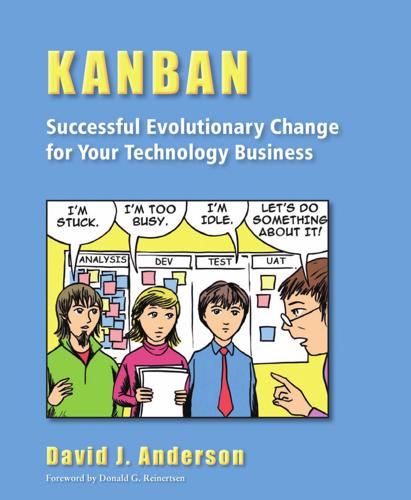
Kanban: Successful Evolutionary Change for Your Technology Business
by
David J. Anderson
Published 6 Apr 2010
I was unaware that Taiichi Ohno, one of the creators of the Toyota Production System had said, “The two pillars of the Toyota production system are just-in-time and automation with a human touch, or autonomation. The tool used to operate the system is kanban.” In other words, kanban is fundamental to the kaizen (“continuous improvement”) process used at Toyota. It is the mechanism that makes it work. I have come to recognize this as a complete truth through my experiences over the five years since. Luckily, Don made a convincing argument that I should switch from Drum-Buffer-Rope implementations to a kanban system for the highly esoteric reason that a kanban system makes a more graceful recovery from an outage in the bottleneck station than Drum-Buffer-Rope system does.
…
The motivation for pursuing a pull-system approach was two-fold: to find a systematic way to achieve a sustainable pace of work, and to find an approach to introducing process changes that would meet with minimal resistance. Kanban is the mechanism that underpins the Toyota Production System and its kaizen approach to continuous improvement. The first virtual kanban system for software engineering was implemented at Microsoft beginning in 2004. Results from early Kanban implementations were encouraging with regard to achieving sustainable pace, minimizing resistance to change through an incremental evolutionary approach, and producing significant economic benefits.
…
Significant improvements are possible by managing bottlenecks, eliminating waste, and reducing the variability that affects customer expectations and satisfaction. Changes can take time to take full effect. This first case study took 15 months to enact. Chapter 5: A Continuous Improvement Culture In Japanese, the word kaizen literally means “continuous improvement.” A workplace culture where the entire workforce is focused on continually improving quality, productivity, and customer satisfaction is known as a “kaizen culture.” Very few businesses have actually achieved such a culture. Companies like Toyota, where employee participation in their improvement program is close to 100 percent, and where, on average, each employee gets one suggestion implemented every year as part of on-going improvement, are very rare.
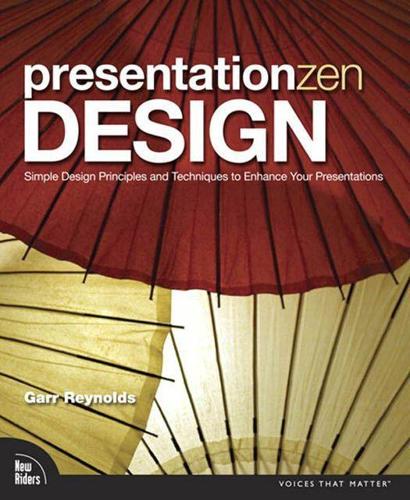
Presentation Zen Design: Simple Design Principles and Techniques to Enhance Your Presentations
by
Garr Reynolds
Published 14 Aug 2010
His point was that printed documents from a presentation tool tend to have less content and less clarity, and yet use more paper, more ink, and more time to produce. In the context of a challenging economy and an atmosphere of reducing costs, what would you say of any business practice that (1) takes more time, (2) costs more money, and yet (3) is less effective? In the spirit of kaizen (continuous improvement), even if the waste is small, it must be eliminated. Don’t confuse slides with documents The difference between slides and documents may be obvious to you. But for many people, it is not. Visuals projected onscreen in support of a live talk are very different from material created for print to be read and analyzed.
…
But in the end, it’s always up to us to learn it, and most of our learning now is a result of our own efforts and our lifelong commitment to continuous improvement through education outside the classroom. Long-Term Improvement: Kaizen The Japanese term kaizen () means “improvement,” literally change + good. In relation to business processes, however, kaizen more closely resembles “continuous improvement.” Kaizen is rooted in the principles of total quality management brought to Japan after World War II by statistician W. Edwards Deming and others. Kaizen is key to the steady improvement and innovation of successful companies in Japan such as Toyota. In the book The Elegant Solution: Toyota’s Formula for Mastering Innovation (Free Press, 2006), author Matthew May says, “Kaizen is one of those magical concepts that is at once a philosophy, a principle, a practice, and a tool.”
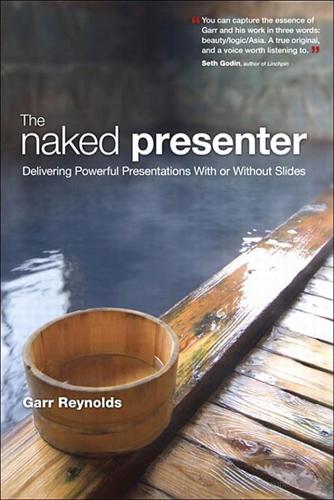
The Naked Presenter: Delivering Powerful Presentations With or Without Slides
by
Garr Reynolds
Published 29 Jan 2010
When you empty your mind of your prejudices, pride, and fear, you become open to the possibilities. 6. Commit to (continuous) growth. Bamboo plants are among the fastest-growing in the world. It does not matter who you are—or where you are today—you have amazing potential for growth. I often speak of kaizen (continuous improvement that is more steady and incremental), where big leaps and bounds are not necessary. Yet even with a commitment to continuous learning and improvement, our growth—like the growth of bamboo—can be quite remarkable when we look back at what or where we used to be. Even though the bamboo outside my window grows quite rapidly, I do not notice its growth from day to day.
…
See also visuals imagination, stimulating, 158 “impatient optimists,” 188 improvement, 188 improvisation, leaving room for, 121 information determining amount of, 40 sharing via stories, 47 interested vs. interesting, 105 international audience, speaking to, 170–171 interruptions, avoiding during preparation, 30–31 interviews for jobs, expressing true self in, 77–79 J Japanese bath (ofuro), 5, 20–23 Japanese forest, seven lessons from, 70–73 Japanese hot springs (onsen), 5– 6 jazz, comparing to presentations, 8– 9, 11, 121 job interviews, expressing true self in, 77–79 Jobs, Steve, 75, 117, 139, 148–151 jounetsu (passion), 100 judo (the way of gentleness), 190 The Naked Presenter Wow! eBook <WoweBook.Com> K N kaizen (continuous improvement, 72 Kanji, 100 karoshi (death by overwork), 47 Kashima Shin School, 124 Kawasaki, Guy, 81 Keynote technology, 9 keynote, presentation tips from, 148– 151. See also presentations Ki (life force), 176 Kodo: Ancient Ways, 71 Nakamura, Masa, 112 naked approach, explained, 10 naked relationship, (hadaka no tsukiai), 5– 6 natural delivery, 25 natural expression of self, 13–14 naturalness, 6 of childhood, 195 speaking with, 7–8 nature Japanese affection for, 6–7 learning from, 6 negatives, overcoming in stories, 44 Negroponte, Nicholas, 129–130 nervousness, avoiding mention of, 74 Newman, Paul, 76–77 notes overcoming dependence on, 15–16 using, 54 Novel aspect of PUNCH, 66– 67 numbers, interpreting, 150, 153 L lavalier mic, considering, 86–87 learning by doing, 144– 145 process of, 72, 111 role of play in, 123 lectern, presenting from, 116 life force (ki), 176 Life in Three Easy Lessons, 176 lifelong learning (shogai gakushu), 186 lights, leaving on, 88 Lusensky, Jakob, 85 M Made to Stick: Why Some Ideas Survive and Others Die, 164 Marsalis, Wynton, 8, 11 martial way (budo), 124 masks, removing, 21 material, knowing, 121 Maui photo of girl, 122–123 Road to Hana, 48 warning sign, 48 McKee, Robert, 43–44, 46 Medina, John, 32, 40, 108, 137–138 memory and emotions, 108 microphone, considering, 86 Mifune, Kyuzo, 190–191 mirror neurons, 110–112 mistakes, overcoming, 119 Miwa, Yoshida, 112 monotone, impact on speeches, 139 Monta Method, 157 Moon, Richard, 176 moving audiences, 34 moving with purpose, 83– 84 multitasking myth, 32 O ofuro (Japanese bath), 5, 20–23 onsen (Japanese hot springs), 5– 6 O-sensei (great teacher), 175 outline, introducing, 75 outside onsen (roten-buro), 21 P pace attention and need for change, 137–138 changing, 140–143 changing for speaking, 159 varying, 136–140 varying in keynotes, 151 participation, 144 asking for volunteers, 156 asking questions, 152 audience activity, 144– 145 building with hands, 156 conducting brainstorming activities, 155 discussion groups, 157 encouraging, 152, 154– 159 showing visuals, 154 sketching ideas, 156 stimulating imaginations, 158 Index 203 Wow!

Agile Project Management With Kanban
by
Eric Brechner
Published 25 Feb 2015
Examples of improvements include a more rigorous acceptance criteria definition, modification of development practices such as code review or unit testing procedures, testing in a staging area that mirrors production, or including a user acceptance test stage before releasing to a wider audience. The act of practicing continuous improvement is often called kaizen in Lean and Agile development circles. * * * Note Kaizen is a Japanese term meaning “good change,” but it is often translated as “continuous improvement,” particularly in the business world. Kaizen involves observing a problem, ideally with metrics such as cycle time, determining the root cause of the problem, making a change to address it, monitoring and measuring the results, and infinitely repeating.
…
Use quick-solve meetings to rapidly reduce the queue of escalations that do not require code changes. Implement a SE workflow using Kanban. Track escalations in the top half of the signboard and bugs and other code work in the lower half of the signboard. Clearly define your done rules for the Kanban workflow. Practice kaizen (continuous improvement) by doing root-cause analysis when bugs are fixed to prevent similar errors in the future. Use work-item management tools where necessary, but give preference to a physical signboard. Tools that integrate the customer-support system and engineering work-item tracking systems can help.

Arriving Today: From Factory to Front Door -- Why Everything Has Changed About How and What We Buy
by
Christopher Mims
Published 13 Sep 2021
It’s a process that never ends, but the result is a system that is, most of the time anyway, predictable and consistent. “We’d do a lot of work to eliminate the root cause of a problem and then go into the kaizen, continuous improvement work, to eliminate the reason why things would be unpredictable,” says Marc. For people who don’t speak Japanese, the language of kaizen and lean production systems can seem like incantations. Instead of waste, practitioners of lean talk about muda. Instead of continuous improvement, kaizen. When a production line stops automatically because of an irregularity, that’s jidoka. Kanban is the scheduling system unique to lean production.
…
A job posting for a health and safety manager at Amazon UK includes, under preferred qualifications: “You possess experience of Lean, 5S and Kaizen methodologies.” (5S is yet another name for lean.) Another posting for a site manager at Amazon Air in the United States begins: “By leveraging lean principles and kaizens, you will lead continuous improvement initiatives.” In a “fireside chat” in 2012, Jeff Bezos related this story, which by his account occurred in 2007 or 2008, soon after Marc arrived at Amazon: “I was in a fulfillment center . . . and we were doing a kaizen training session with a Japanese consultant . . . He was from the Toyota school of kaizen . . .
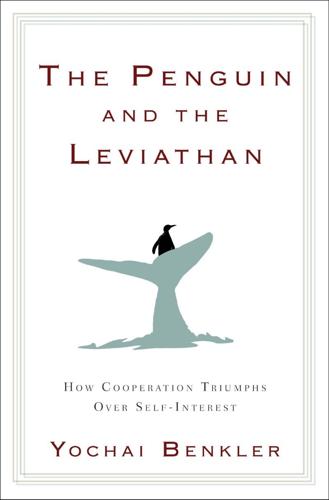
The Penguin and the Leviathan: How Cooperation Triumphs Over Self-Interest
by
Yochai Benkler
Published 8 Aug 2011
And since expanding workers’ range of knowledge and job flexibility required much greater investment in job training, employees received more than five times as many training hours under NUMMI (some on company time, some on their own) as they had under General Motors. Another big change was that the new management introduced the then unheard-of Japanese practice of kaizen: continuous improvement. With Toyota in charge, even the very lowest-ranking assembly-line worker could raise and vet proposals for improvements, which, if approved, became standard procedure. After a few years, Toyota introduced Problem Solving Circles, volunteer brainstorming sessions conducted informally, over lunch, which was provided by the company (never underestimate the power of free food).
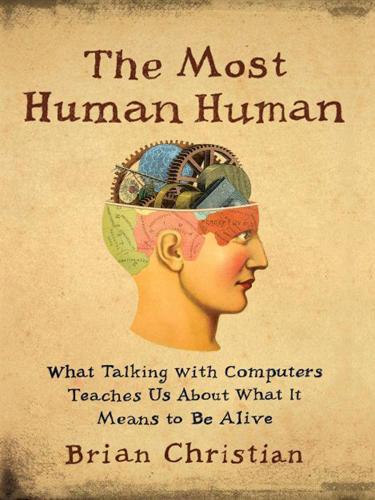
The Most Human Human: What Talking With Computers Teaches Us About What It Means to Be Alive
by
Brian Christian
Published 1 Mar 2011
One of the biggest differences, it turned out, between the two companies was that at Toyota, “when a worker makes a suggestion that saves money, he gets a bonus of a few hundred dollars or so. Everyone’s expected to be looking for ways to improve the production process. All the time. This is the Japanese concept of kaizen, continuous improvement.” One American GM worker was part of a group that traveled to Japan to try building cars on the Toyota assembly line, and the difference in the experience stunned him: I can’t remember any time in my working life where anybody asked for my ideas to solve the problem. And they literally want to know.
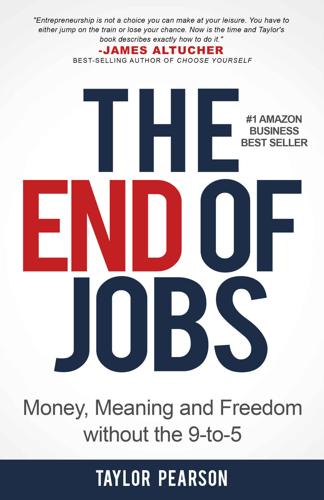
The End of Jobs: Money, Meaning and Freedom Without the 9-To-5
by
Taylor Pearson
Published 27 Jun 2015
But to create truly remarkable work, the most important factors were the same intrinsic factors cited by Deci and Csikszentmihalyi. W. Edwards Deming made the same argument in his work with Japanese firms, advocating creating more intrinsic motivation as the route to quality and continual improvement. His work, which was eventually brought over to America in the form of kaizen (or continuous improvement), created billions of dollars in value for companies around the world.56 What Deming, Deci, Herzberg, and Csikszentmihalyi all found can be summed up in two statements: We are naturally predisposed to be growing, goal-seeking, striving creatures. By following that impulse we can create more valuable work.

Capital Allocators: How the World’s Elite Money Managers Lead and Invest
by
Ted Seides
Published 23 Mar 2021
The pump intake was clogged with metal shavings. 5. Why was the intake clogged with metal shavings? Because there was no filter on the pump. Each question in Ohno’s example mirrors a piece of the answer to a previous question. The Five Whys is rooted in the Japanese concept of kaizen, or continuous improvement. 2. Favorite questions Allocators investigate the key drivers of a manager’s success as they move along in the process. Some popular topics explore a manager’s incentives, competitive advantage, self-awareness, culture, competitive landscape, and expectations. Allocators cleverly ask simple questions, hiding the in-depth thought process that qualifies the answers.

Seeking SRE: Conversations About Running Production Systems at Scale
by
David N. Blank-Edelman
Published 16 Sep 2018
Start by Leaning on Lean If you are going to transform how your operations organization works, you might as well leverage a proven body of transformational knowledge. The Lean manufacturing movement has produced a wealth of design patterns and techniques5 that we can apply to improve any work process. In particular, it is the principle of Kaizen (which roughly translates to “continuous improvement”), born from the Toyota Production System, that speeds transformations and drives an organization’s ability to learn continuously. To bring Kaizen to an organization, there is a method called Kata, also based on Toyota Production System. Kata is an excellent methodology to apply to the challenge of eliminating toil, silos, and request queues.
…
interrupt work, project work vs., We love interrupts and the torrents of information interviewing (job interviews), Interviewing Site Reliability Engineers-Final Thoughts on Interviewing SREsadvice for hiring managers, Advice for Hiring Managers and persons with mental disorders, Interviewing basics, Interviewing 101-The Funnel biases in, Biases funnel basics, The Funnel funnels, SRE Funnels-Final Thoughts on Interviewing SREs industry vs. university candidate profiles, Industry Versus University onsite interview, The Onsite Interview phone screens, Phone Screens selling candidates on your organization, Selling candidates take-home questions, Take-Home Questions walking away from a candidate, Walking away IPython, Installing Python, IPython, and Jupyter Notebook isolationand data durability, Isolation-Operational isolation logical, Logical isolation of failure domains, Isolated failure domains operational, Operational isolation-Operational isolation physical, Physical isolation J Jansson, Mattias, SRE Without SRE, SRE Without SRE: The Spotify Case Study-The Future: Speed at Scale, Safely job application/hiring processas funnel process, The Funnel benefits for applicants with mental disorders, Benefits-Benefits compensation and applicants with mental disorders, Compensation for persons with mental disorders, Interviewing interviewing SREs (see interviewing) onboarding packets, Onboarding job duties, for persons with mental disorders, Job Duties job function, on-call as, Application job postings, Application Joblint, Application Johnston, Bennie, Replies joint cognitive system (JCS), SREs Are Cognitive Agents Working in a Joint Cognitive System, Focus on Making Automation a Team Player in SRE Work Jones, Matt, Replies Jupyter Notebook, Installing Python, IPython, and Jupyter Notebook K Kaizen (continuous improvement), Start by Leaning on Lean-Start by Leaning on Lean Kanban, Unify Backlogs and Protect Capacity Kanwar, Pranay, Replies Kasparov, Garry, From Chess to Go: How Deep Can We Dive? Kata method, Start by Leaning on Lean-Start by Leaning on Lean Kelvin, Lord (William Thomson), From SysAdmin to SRE in 8,963 Words, Where Did SRE Come From?

Ludicrous: The Unvarnished Story of Tesla Motors
by
Edward Niedermeyer
Published 14 Sep 2019
But it remains most effective—indeed, necessary—in the massive and complex business of making cars, where every step in global supply chains is an opportunity for defects and inefficiencies to work into the system. One of the best known and most fundamental principles of lean manufacturing culture is kaizen, or continuous improvement. This goes in hand with another core value, long-term perspective. Both of these principles are part of Toyota’s managerial approach, called the Toyota Way. Not only are these principles the best method to improve performance in a business as large and complex as an automaker, they are also the only way to build a successful culture.
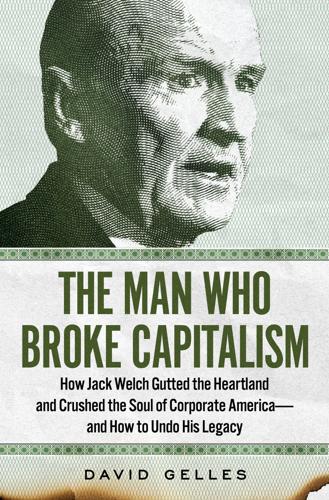
The Man Who Broke Capitalism: How Jack Welch Gutted the Heartland and Crushed the Soul of Corporate America—and How to Undo His Legacy
by
David Gelles
Published 30 May 2022
Thanks to misguided acquisitions and persistently high costs in the United States, the division constantly struggled to turn a profit. But McNerney found other ways to ingratiate himself with Welch. In the mid-1990s, McNerney became one of the most zealous champions of Six Sigma, a new quality improvement methodology that Welch was pushing on the company. Inspired by the Japanese notion of kaizen, or continuous improvement, Six Sigma used a complex system of feedback and buzzwords to try and root out any lingering vestiges of inefficiency. Whether it actually helped or just created a lot of paperwork was a subject of fierce debate. But during Welch’s heyday, championing Six Sigma was a must for executives hoping to stay in the boss’s good graces, and McNerney embraced the cause with gusto.
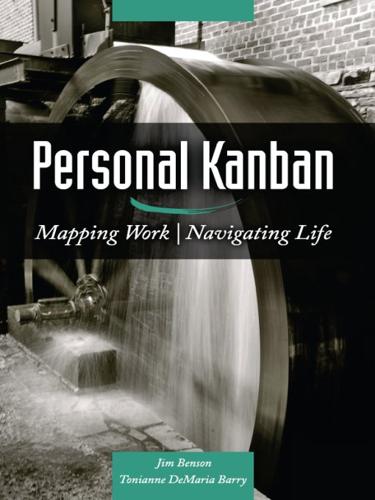
Personal Kanban: Mapping Work, Navigating Life
by
Jim Benson
and
Tonianne Demaria Barry
Published 2 Feb 2011
Lean is both a philosophy and a discipline which, at its core, increases access to information to ensure responsible decision making in the service of creating value. With increased access to information people feel more respected, teams are more motivated, and waste is reduced. Much of this waste reduction comes from Lean’s goal of a “kaizen” culture. Kaizen is a state of continuous improvement where people naturally look for ways to improve poorly performing practices. Personal Kanban facilitates kaizen. When we visualize our work, we adopt a kaizen mindset; we are weened from the comfort of complacency and actively seek out opportunities for improvement. Our brains become sensitized to patterns of waste and ineffectiveness.

Blockchain Chicken Farm: And Other Stories of Tech in China's Countryside
by
Xiaowei Wang
Published 12 Oct 2020
Agile methods have been at the heart of modern technology’s growth. While hardware advances have enabled more sophisticated software, such software would not exist without the particular working processes and collaboration methods that bind tech companies together. These processes that enable companies to run lean draw upon gemba kaizen, or the art of continuous improvement, pioneered by Japanese management consultants. Gemba kaizen emphasizes cutting away waste, and ensuring that workers and managers are aligned, decreasing miscommunications and wasted time, known as “thrash.” Originally used as a working process in Japanese manufacturing, agile methods in software are now spilling back over into other industries.
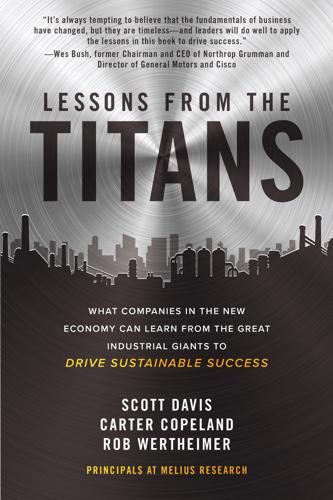
Lessons from the Titans: What Companies in the New Economy Can Learn from the Great Industrial Giants to Drive Sustainable Success
by
Scott Davis
,
Carter Copeland
and
Rob Wertheimer
Published 13 Jul 2020
ADDING CONTINUOUS IMPROVEMENT While these successful acquisitions were building out scale and complexity, there was a separate effort going on internally to build more value from the purchased companies and create more sustainable competitive advantages for United Rentals as a whole. In 2013, the company began a series of kaizen events, a move pitched to Flannery by the employee base. This was the beginning of a formal process of continuous improvement and the creation of a true business system. Although some of the methods of continuous improvement come directly from manufacturing, as a tool it can be applied to anything. In the end, anyone can still dump in capital and attempt to replicate some of the scale that United Rentals has built, though it’s much harder now.
…
However, the competitive edge afforded by doing thousands of things just a little bit better is hard to match. It began with eight kaizen events at eight branches. The response was hugely positive. Employee engagement in the process was strong, and soon the company was running kaizen events in every district. Above all, continuous improvement fundamentally needs employee engagement, but it is also a managed process, implemented by line managers and unlikely to catch hold without strong support from senior leadership. All the district managers at the company spent 30 percent of their time in the first six months on kaizens and on managing improvement.
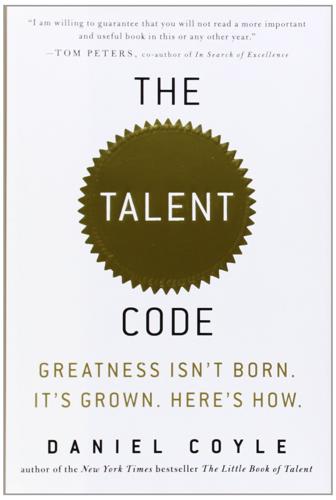
The Talent Code: Greatest Isn't Born, It's Grown, Here's How
by
Daniel Coyle
Published 27 Apr 2009
The more an organization embraces the core principles of ignition, deep practice, and master coaching, the more myelin it will build, the more success it will have. Thirty years ago Toyota was a middling-size car company. Now it is the world's largest automaker. Most analysts attribute Toyota's success to its strategy of kaizen, which is Japanese for “continuous improvement” and which just as easily could be called corporate deep practice. Kaizen is the process of finding and improving small problems. Each employee, from the janitor on up, has authority to halt the production line if they spot a problem. (Each factory has pull cords on the factory floor, called andons.)

The 1% Rule: How to Fall in Love With the Process and Achieve Your Wildest Dreams
by
Tommy Baker
Published 18 Feb 2018
Whether they are trying to solve a major scientific mystery or simply produce a high-quality product or service, everyday progress—even a small win—can make all the difference in how they feel and perform.” This can’t be overstated. It is the basis of the ethos behind the 1% Rule. The 1% Rule stems from this principle and combines it with the Japanese philosophy of kaizen. This philosophy is about continuous improvement over the long haul. These two come together to create undeniable daily micro-progress. When combined with consistency and time, the compound effect takes over and we not only achieve the most audacious of goals, we go above and beyond our wildest dreams. The 1% Rule: 1% progress + daily application (consistency) + persistence (focus) + time (endurance) = success.
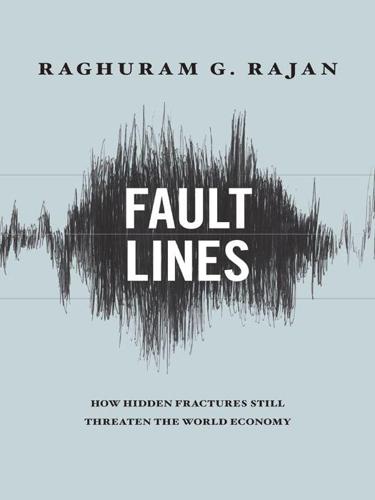
Fault Lines: How Hidden Fractures Still Threaten the World Economy
by
Raghuram Rajan
Published 24 May 2010
3 In some jobs, it is very hard to see the effects of one’s work. On an assembly line, a worker is just one cog in a huge production machine, and her role in the final product may be small. No wonder modern management techniques try to make each worker feel important both individually and as part of a team: the Japanese kaizen system of continuous improvement, for example, involves all workers in making changes to enhance productivity, no matter how small the changes might be. Many jobs in a competitive, arm’s-length financial system are problematic for two reasons: First, like the worker on an assembly line, the broker who sells bonds issued by an electric power project rarely sees the electricity that is produced: she has little sense of any material result of her labors.

Making It in America: The Almost Impossible Quest to Manufacture in the U.S.A. (And How It Got That Way)
by
Rachel Slade
Published 9 Jan 2024
At the very least, maybe there was a way to reduce handling time—the seconds between picking up a piece, moving a piece under the needle, and actually stitching it. He also thought there were ways to incentivize working smarter. Poking around the internet, he stumbled on a manufacturing strategy called kaizen, Japanese for “continuous improvement.” The strategy was based on the idea that you could vastly improve a system by making tiny, empirical tweaks. Toyota was the first major company to fully apply the philosophy to every facet of its organization (which is why it’s often called the Toyota Method), but it was originally an American concept.
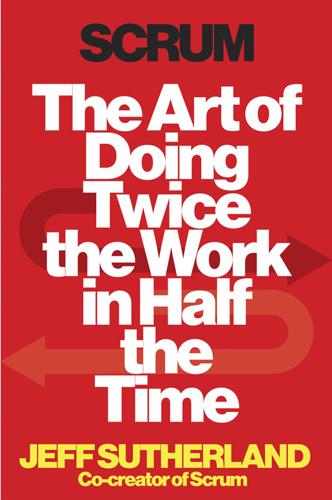
Scrum: The Art of Doing Twice the Work in Half the Time
by
Jeff Sutherland
and
Jj Sutherland
Published 29 Sep 2014

5 Day Weekend: Freedom to Make Your Life and Work Rich With Purpose
by
Nik Halik
and
Garrett B. Gunderson
Published 5 Mar 2018
“Spend each day trying to be a little wiser than you were when you woke up. Step by step you get ahead. You build discipline by preparing for fast spurts.” —CHARLIE MUNGER It’s about commitment. It’s about steady and sustained improvement, versus sporadic effort that fizzles out. The term I like for it is “kaizen,” which is a Japanese word referring to the process of continuous improvement. The idea of kaizen is that big results come from many small changes accumulated over time. My challenge to you is to increase your income by 3 percent each month, at least for the first couple of years of your 5 Day Weekend journey. This becomes a 38.4 percent increase in income at the end of your first year.
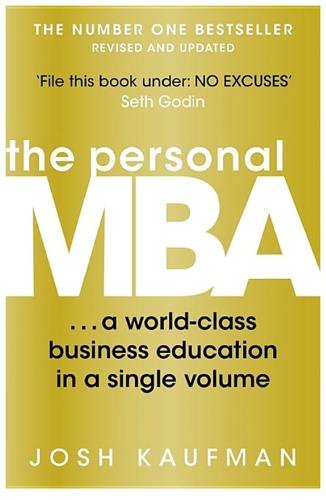
The Personal MBA: A World-Class Business Education in a Single Volume
by
Josh Kaufman
Published 2 Feb 2011
It’s little wonder that Toyota is now the world’s largest and most valuable automotive manufacturer.4 Small helpful or harmful behaviors and inputs tend to Accumulate over time, producing huge results. According to Lean Thinking by James P. Womack and Daniel T. Jones, Toyota’s approach is based on the Japanese concept of kaizen, which emphasizes the continual improvement of a system by eliminating muda (waste) via a lot of very small changes. Many small improvements, consistently implemented, inevitably produce huge results. Accumulation isn’t always positive. Think of what would happen to your body if you consumed nothing but fast food, candy bars, and soda for a decade.

Kanban in Action
by
Marcus Hammarberg
and
Joakim Sunden
Published 17 Mar 2014
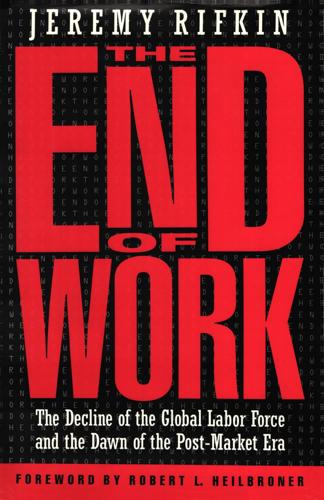
The End of Work
by
Jeremy Rifkin
Published 28 Dec 1994
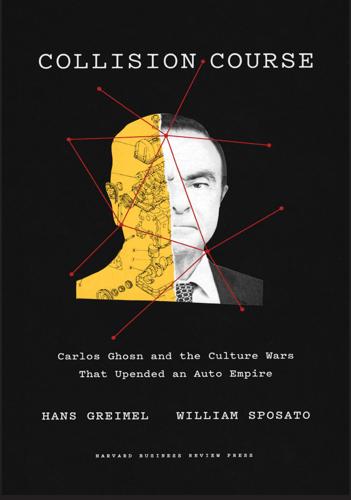
Collision Course: Carlos Ghosn and the Culture Wars That Upended an Auto Empire
by
Hans Gremeil
and
William Sposato
Published 15 Dec 2021
Some at Renault also feared being blotted out by Nissan’s massive size. To the chagrin of French traditionalists, Renault began internalizing elements of Japanese corporate culture, and Japanese ways slowly infiltrated the company. Japanese loanwords, such as gemba, a reference to frontline operations, such as the factory floor, or kaizen, meaning the pursuit of continual improvement, became ingrained in Renault parlance. “Japanese industrial culture was imported to Renault. That was quite difficult for some people in Renault,” said a former adviser to Ghosn at the French company. “Nissan had historical superiority in engineering, and the Renault side caught up in recent years.

British Rail
by
Christian Wolmar
Published 9 Jun 2022
They also reflected an interest in learning some of the secrets of Japan’s ‘economic miracle’, including her enthusiasm for keiretsu (loose but effective conglomerate holding companies), the obsession with quality, first advanced by [the noted management consultant guru] Edwards Deming, and the kaizen (continuous process) approach to management-led improvement.6 In other words, British Rail was at the forefront of contemporary modern management thinking. In terms of staffing, one of the biggest effects of OfQ was to reduce the number of staff working at headquarters to just 640 from 17,000, most of whom were redeployed to the sectors, although there were a few redundancies.
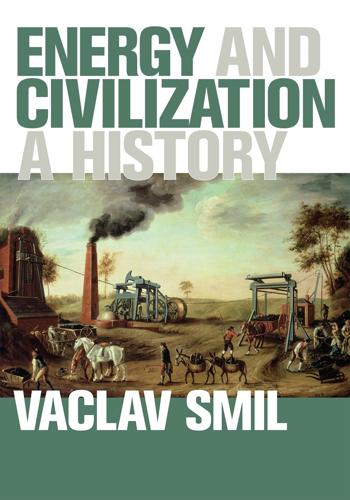
Energy and Civilization: A History
by
Vaclav Smil
Published 11 May 2017
The modern, flexible Japanese kind relies on just-in-time delivery of parts and on workers capable of doing a number of different tasks. The system, introduced in Toyota factories, combined elements of American practices with indigenous approaches and original ideas (Fujimoto 1999). The Toyota production system (kaizen) rested on continuous product improvement and dedication to the best achievable continuous quality control. Again, the fundamental commonality of all of these actions is minimizing energy waste. The availability of inexpensive electricity has also created new metal-producing and electrochemical industries. Electricity allowed the large-scale smelting of aluminum by the electrolytic reduction of alumina (Al2O3) dissolved in an electrolyte, mainly cryolite (Na3AlF6).
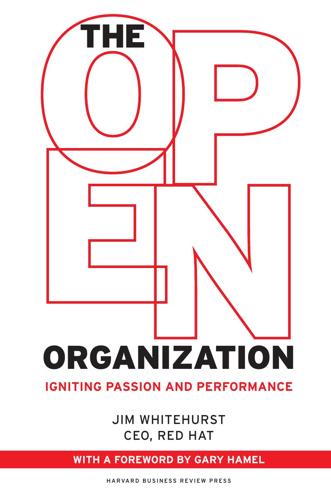
The Open Organization: Igniting Passion and Performance
by
Jim Whitehurst
Published 1 Jun 2015
Over time, we’ve observed that this methodology not only reduces the risk of bugs, but also leads to greater innovation. It turns out that making many small improvements continuously ultimately creates more innovation. Perhaps this shouldn’t be surprising. One key tenet of modern manufacturing process methodologies, like kaizen or lean, is to continually focus on small, iterative improvements. As Clay Shirky, author of Here Comes Everybody, comments about open source: “Because anyone can try anything, the projects that fail, fail quickly, but the people working on those projects can migrate just as quickly to the things that are visibly working. Unlike the business landscape, where companies have an incentive to hide both successes (for reasons of competitive advantage) and failures (to forestall any perception of weakness), open source projects advertise their successes and get failure for free.”8 Like so many other aspects of its management system, Red Hat has adopted this same principle for internal initiatives.

Machines of Loving Grace: The Quest for Common Ground Between Humans and Robots
by
John Markoff
Published 24 Aug 2015
However, one intriguing shift that suggests there are limits to automation was the recent decision by Toyota to systematically put working humans back into the manufacturing process. In quality and manufacturing on a mass scale, Toyota has been a global leader in automation technologies based on the corporate philosophy of kaizen (Japanese for “good change”) or continuous improvement. After pushing its automation processes toward lights-out manufacturing, the company realized that automated factories do not improve themselves. Once Toyota had extraordinary craftsmen that were known as Kami-sama, or “gods” who had the ability to make anything, according to Toyota president Akio Toyoda.49 The craftsmen also had the human ability to act creatively and thus improve the manufacturing process.

Alpha Trader
by
Brent Donnelly
Published 11 May 2021
Instead, embrace the surprising plasticity of the human brain and keep learning, evolving, and improving. This concept is similar to the Japanese concept of Kaizen or “good change” which was a key ingredient in the superior quality and productivity of the Japanese automakers as they eclipsed North American car makers in the 1980s. With Kaizen or Growth Mindset (aka, continuous improvement), you always look to make incremental positive changes and continue to grow. Without a growth mindset, this book is not going to help you much because you will wrongly believe that many of the traits, strengths, and weaknesses you possess are fixed or too difficult to change.

The Billionaire and the Mechanic: How Larry Ellison and a Car Mechanic Teamed Up to Win Sailing's Greatest Race, the Americas Cup, Twice
by
Julian Guthrie
Published 31 Mar 2014
While Russell had proved himself over the years and deserved to be rewarded for his successes, he would have control of the team only if he continued his winning ways and won the America’s Cup again, this time for Oracle Team USA. In the first two campaigns, Larry had operated under the Japanese business principle kaizen, a term used to describe continuous improvement or incremental change through constant work. Larry was starting over with someone who had never lost an America’s Cup race. “I tried kaizen,” Larry said, “It didn’t work. So we’re making radical changes, starting with a new leader for our team.” The two losses had taught many lessons.

WTF?: What's the Future and Why It's Up to Us
by
Tim O'Reilly
Published 9 Oct 2017
Many of these deployments are of experimental features that may be rolled back or further modified. The capability to roll something back easily makes failure cheap and pushes decision making further down into the organization. Much of this work is completely automated. Hal Varian calls this “computer kaizen,” referring to the Japanese term for continuous improvement. “Just as mass production changed the way products were assembled and continuous improvement changed how manufacturing was done,” he writes, “continuous experimentation . . . improve[s] the way we optimize business processes in our organizations.” But DevOps also brings higher reliability and better responsiveness to customers.
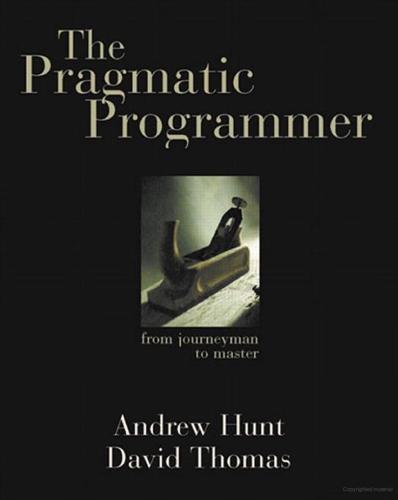
The Pragmatic Programmer
by
Andrew Hunt
and
Dave Thomas
Published 19 Oct 1999
asked the tourist. "Absolutely," replied the gardener. "Do that for 500 years and you'll have a nice lawn, too." Great lawns need small amounts of daily care, and so do great programmers. Management consultants like to drop the word kaizen in conversations. "Kaizen" is a Japanese term that captures the concept of continuously making many small improvements. It was considered to be one of the main reasons for the dramatic gains in productivity and quality in Japanese manufacturing and was widely copied throughout the world. Kaizen applies to individuals, too. Every day, work to refine the skills you have and to add new tools to your repertoire.
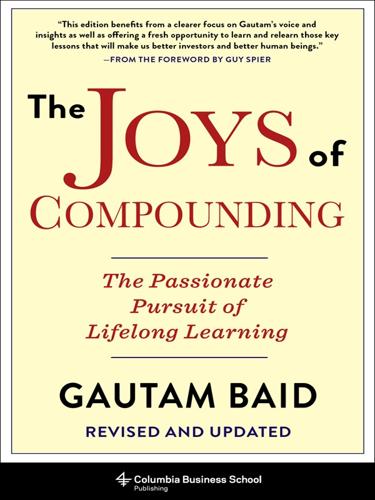
The Joys of Compounding: The Passionate Pursuit of Lifelong Learning, Revised and Updated
by
Gautam Baid
Published 1 Jun 2020
It requires a tremendous amount of patience, consistency, dedication, and a deep conviction in the power of compounding. One Small Step at a Time One Small Step Can Change Your Life: The Kaizen Way by Robert Maurer is one of my favorite books. It talks about the power of compounding small daily positive actions. This small book talks about the big idea of kaizen, which is Japanese for “taking small steps for continual improvement.” The difference between those who fail and those who succeed is the courage to act—repeatedly. Most people, when faced with change, will feel at least some element of fear. Very often that fear can get in the way of actually making the change. The idea of kaizen is to make such small changes in your life that your brain doesn’t even realize that you are trying to change and therefore doesn’t get in the way.
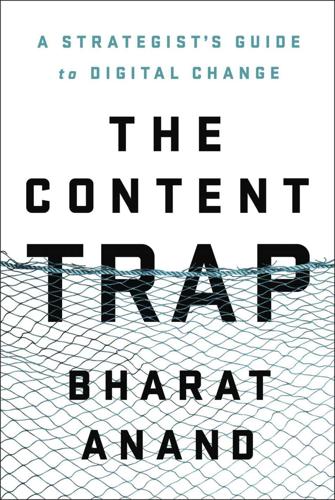
The Content Trap: A Strategist's Guide to Digital Change
by
Bharat Anand
Published 17 Oct 2016
Within a couple of years its founders refashioned it as an operational firm modeled on Toyota. Japanese firms were outperforming their American counterparts by large margins at the time, achieving impressive productivity on shop floors. Process improvement was the rage, terms like lean manufacturing and kaizen the buzzwords. Danaher embraced it all, and then some. Lean processes and continuous improvement became part of the company’s famous toolkit, the Danaher Business System, which it refined and enlarged during the next three decades and applied relentlessly across the businesses it acquired, “Danaherizing” them by sending managers at all levels through DBS training.

Faster, Higher, Farther: How One of the World's Largest Automakers Committed a Massive and Stunning Fraud
by
Jack Ewing
Published 22 May 2017
Long an admirer of the Japanese, Piëch set about copying their manufacturing methods in much the same way that his grandfather had copied Ford when planning the Volkswagenwerk in the 1930s. New factories in Mosel, in East Germany, and in Martorell, a Spanish city near Barcelona, presented blank slates where Piëch could try out Japanese-style production methods. Under Piëch, Volkswagen copied the Toyota kaizen system of assembly line teams, where all workers were encouraged to continually look for ways to improve quality or save time and money. For example, female workers in a Volkswagen upholstery department complained that it was difficult to pull the covers over headrests. After employees and supervisors met to discuss the problem, someone found an unused machine that was modified to compress the foam padding on the headrest, so the cover could be pulled on faster and with less effort.